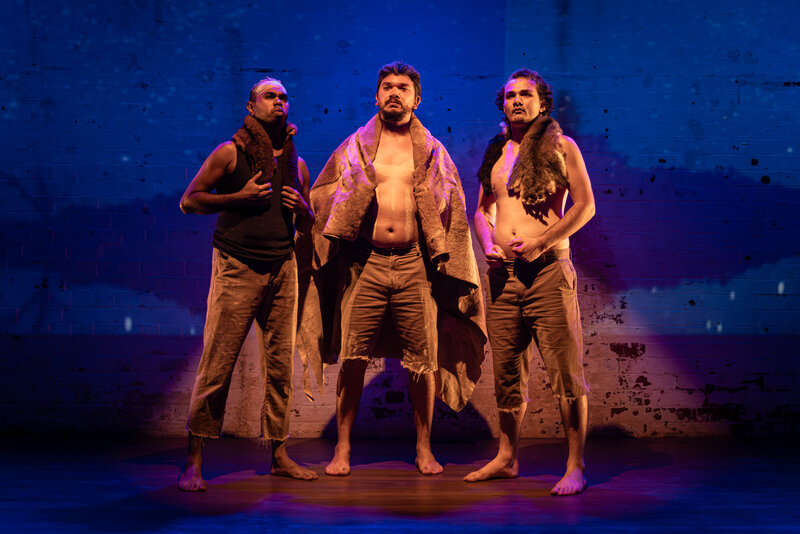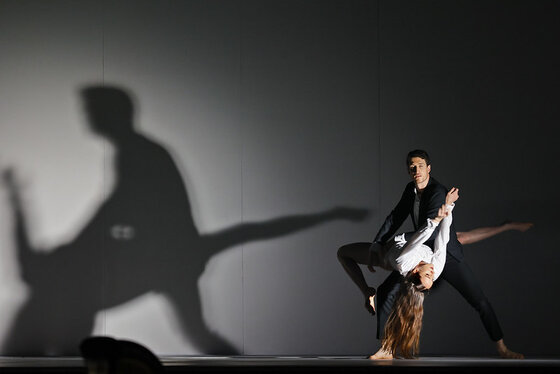“I think it’s wonderful that this film is being released at a time when, at last there is clearly a majority of people in the country who believe in the rights of same sex marriages to exist,” says director Neil Armfield. He is talking about his screen adaptation of Holding The Man, Timothy Conigrave’s moving posthumous 1995 memoir of his fifteen year love with John Caleo, whom he first met at Xavier in the 1970s. “It’s something that is sweeping certain parts of the world, and Tim and John’s story is part of that movement.”
For a man who has just arrived from the airport and is embarking on a gruelling round of press interviews to promote the feature film, Armfield looks remarkably relaxed. Sitting comfortably on a sofa in his suite in Melbourne’s Sofitel Hotel, Armfield leans forward and pauses reflectively before answering each question.
Armfield is a respected director of film, stage and television. In 2013 he helmed Australia’s first full length production of Wagner’s epic Ring Cycle in Melbourne, and he has directed numerous stage productions, including operas and Shakespeare. His stage work includes Hamlet, Waiting For Godot, The Diary Of A Madman, The Marriage Of Figaro, Billy Budd, etc. His last feature film was Candy in 2006, starring the late Heath Ledger and Abbie Cornish as a pair of doomed drug addicts.
 So, is he attracted to stories about doomed relationships? Armfield laughs, and shrugs. “Yes, it’s a funny thing isn’t it? But I’ve also done quite happy things, on stage especially. But yes, it might be something circumstantial. I haven’t analysed it yet.
So, is he attracted to stories about doomed relationships? Armfield laughs, and shrugs. “Yes, it’s a funny thing isn’t it? But I’ve also done quite happy things, on stage especially. But yes, it might be something circumstantial. I haven’t analysed it yet.
“I don’t think of this as a doomed relationship,” he continues. “I think Candy was a doomed relationship, but I don’t think that this is. I think that the love between Tim and John was, in a sense, a love that was fully lived. We have a mortal span and most people get to live a life two or three times as long as the life that John and Tim were given to live so fully and to express that love so fully in the time that they had. Their bodies gave out, but their love continues I think. It would only be a doomed love story if that love were doomed in a sense. The fact is that they lived at a time when no-one saw this coming.”
Unlike Brokeback Mountain, which was a story about two gay men who didn’t know they were gay until they found each other and then they struggled with the secret and the pressure of the closet, Holding The Man is a timeless love story that can rightly be seen and understood and experienced by anyone who has experienced love. The film beautifully explores the pressures of being gay and growing up in families in which that was not an acceptable option. “The way Tim and John lived their lives is a story of great liberation,” explains Armfield. “To get that story further out into the world is creating a triumph for what their love was.”
Holding The Man has personal resonance and deeper significance for Armfield who lived as a gay man through the same period and saw so many friends contract AIDS and die. Tim and John started out with this incredible optimism, being at high school in the 70s and still finding out who they were, but sensing a desire for each other and acting on it. After John’s death, Conigrave struggled with his own dementia and wrote his story down.
Armfield was first introduced to Conigrave’s book by playwright and writer Nick Enright, who had sat with Tim on his deathbed for many months helping him to edit his memoirs. Nick had taught Tim at NIDA as an actor, and recognised the playwright and writer in Tim. In 1995 Armfield made a film for television with Enright, who gave him the book to read. Armfield tried to get the film rights back then, but they were unavailable. Armfield turned his attention to operas and plays. Eighteen years later he got the call asking if he would like to do the film.
 “At that point I’d forgotten that I had tried to get the rights,” he confesses, “and I only remembered that after I had finished making the film. So I don’t know why it’s really taken this long. Maybe it’s the zeitgeist.”
“At that point I’d forgotten that I had tried to get the rights,” he confesses, “and I only remembered that after I had finished making the film. So I don’t know why it’s really taken this long. Maybe it’s the zeitgeist.”
The screenplay was written by Tommy Murphy who in 2006 adapted the novel into a successful stage play. Murphy (who recently wrote the television drama The Devil’s Playground) was intimately familiar with the material, and very respectful of the process, he was also pretty new to the process. “Tommy and I are both gay artists and so we both had our own experiences of family,” Armfield continues. “Both of us grew up in very loving families, like Tim and John. From my own experience there was a period of adjustment for them in dealing with my revelation about my sexuality which I think was true to John and Tim. Tommy is from another generation, and things had moved on quite a bit I think in his experience.”
But it was very much a question of going back to the book rather than building on the stage adaptation. “Tommy and I returned to the book and wove our way through, losing stuff on every page, in order to find a really strong cinematic structure. And there were things you could do on the screen. For instance, the last time that the boys make love when John comes home from the hospital with Tim, is described as a scene of such extraordinary intimacy. The one thing a film can be is intimate in a way that no other art form can be in the same way I suppose. What works on the stage doesn’t necessarily work at all on film,” admits Armfield.
He admits that, as with his adaptation of Candy a decade earlier, he felt a lot of pressure in bringing this beloved book to the screen. “You get people who are fans of the book who say they can’t wait to see how you do so and so,” he elaborates. And the same thing happened with Candy. “There are so many things that can work in a novel that have no place really on the screen. You have to find your own way of telling it and responding to the energy within that work, you have to stay true to the spirit and intention of the book even though at the time you might be making up new incidents.”
Initially Armfield had considered using different actors to play Tim and John as schoolboys, but once he found Ryan Corr (from Not Suitable For Children, The Water Diviner, etc) and Craig Stott, who were both 24 at the time, he went with the decision to use them all the way through the film. Ryan and Craig were both great because they were so open for anything he says. They rehearsed over at the Victorian AIDS council who very generously gave them a space and a lot of background information to the period and to medical procedures that Tim and John went through. But the pair would also start to walk around the street at lunch time holding hands and experiencing how people in the bank or at the sandwich shop would look at them. Armfield suggests that though things are slightly different now to what it was back in the late 70s or early 80s when Tim and John were a couple, that sense of disapproval and surprise is still something that gay couples are coming up against.
 “It was great that Craig and Ryan wanted to experience that,” Armfield enthuses about their level of commitment to the roles. “And we talked a lot, we laughed a lot. With any situation, with rehearsal and with filming, I try to set up a room which is relaxed, in which people feel free to take risks. And that was true of the Holding The Man set as much as anywhere else, and it’s crucial with actors that they feel safe. That that’s not just about doing gay stuff it’s true about doing any kind of performance. Cliche and assumption can destroy something that has the potential to be original. And that was very important just to create a very safe space in which they could explore.”
“It was great that Craig and Ryan wanted to experience that,” Armfield enthuses about their level of commitment to the roles. “And we talked a lot, we laughed a lot. With any situation, with rehearsal and with filming, I try to set up a room which is relaxed, in which people feel free to take risks. And that was true of the Holding The Man set as much as anywhere else, and it’s crucial with actors that they feel safe. That that’s not just about doing gay stuff it’s true about doing any kind of performance. Cliche and assumption can destroy something that has the potential to be original. And that was very important just to create a very safe space in which they could explore.”
Armfield received great support from the administration of Xavier College, who allowed him to film some scenes at their campus. “Everyone we talked to at Xavier spoke about what a special person John Caleo was, that he had this kind of almost angelic quality and that he was so loved. Xavier were brilliant in the way they supported this film. They are also very proud of Tim Conigrave’s book.”
Armfield says that he was lucky to pull together such a strong cast who all believed in the material. The cast includes Guy Pearce and Kerry Fox as Tim’s more sympathetic parents, and Anthony LaPaglia as John’s disapproving father. In the novel John’s father was quite a formidable presence in John’s life. He was a man of strong Italian heritage, the father of five sons. John’s father was a very strict Catholic – there was no way in the Catholic teaching for homosexuality to be condoned or understood, and that would have been a hugely difficult and problematic thing for him to understand. It was disappointing and must have seemed like betrayal, and while his father still made some hard decisions he was acting out of love in trying to protect John.
“My job as a director is to help the audience understand what is motivating every character,” Armfield says. “Everyone acts out of love. I think no-one is willfully trying to be mean. It’s how you get the audience to understand what sits behind that love.”
There is a powerful moment in the film where Tim says to the priest who is going to officiate at John’s funeral: ‘We’ve been together for fifteen years, he’s my husband.’ This was well before there was any debate about same sex marriage. “It may be a very valuable story from our recent past to feed into that debate,” Armfield comments. “And certainly I don’t think the timing could be better than now for this story to again become part of our national culture. Understanding how society and how families were helps us to understand how societies and families are and how societies and families might be in the future.
“And I think it’s wonderful that this film is being released at a time when, at last, there is clearly a majority of people in the country who believe in the rights of same sex marriages to exist. And it’s something that is sweeping certain parts of the world, and Tim and John’s story is part of that movement. But we’ve got a prime minister who is stubbing his foot on every thing he walks past at the moment. And the fact that he can’t see what is so blindingly obvious in front of him makes you wonder.”
Holding the Man opens nationally today.
Greg King

David Edwards is the former editor of The Blurb and a contributor on film and television




